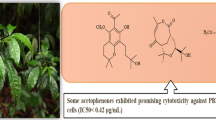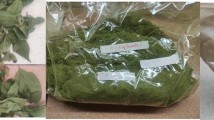Abstract
Phenolic compounds are prevalent as toxins or environmental pollutants, but they are also widely used as drugs for various purpose including anticancer agent. A novel biphenolic compound, bis(2-hydroxy-3-tert-butyl-5-methylphenyl)methane (GERI-BP002-A) was isolated from the fermentation broth ofAspergillus fumigatus F93 previously, and it has revealed cytotoxicity against human solid tumor cells. Its effective doses that cause 50% inhibition of cell growthin vitro against non-small cell lung cancer cell A549, ovarian cancer cell SK-OV-3, skin cancer cell SK-MEL-2 and central nerve system cancer cell XF498 were 8.24, 10.60, 8.83, 9.85 μg/ml respectively. GERI-BP002-A has also revealed cytotoxicity against P-glycoprotein-expressed human colon cancer cell HCT15 and its multidrug-resistant subline HCT15/CL02, and its cytotoxicity was not affected by P-glycoprotein. We have also tested cytotoxicities of structurally related compounds of GERI-BP002-A such as diphenylmethane, 1,1-bis(3,4-dimethylphenyl)ethane, 2,2-diphenylpropane, 2-benzylpyridine, 3-benzylpyridine, 4,4′-di-tert-butylphenyl, bibenzyl, 2,2′-dimethylbibenzyl,cis-stilbene,trans-stilbene, 3-tert-butyl-4-hydroxy-5-methylphenylsulfide, sulfadiazine and sulfisomidine for studying of structure and activity relationship, and from these data we could suppose that hydroxyl group of GERI-BP002-A conducted important role in its cytotoxicity.
Similar content being viewed by others
References Cited
Bello-Reuss, E. and Ernest, S., Expression and function of P-glycoprotein in human mesangial cells.Am. J. Physiol., 267, c1351-c1358 (1994).
Boven, E., Winograd, B., Fodstad, O., Lobbezoo, M. W. and Pinedo, H. M., Preclinical phase II studies in human tumor lines: a european multicenter study.Eur. J. Cancer Clin. Oncol., 24, 567–573 (1988).
Brown, T. D., Burris, H. A., Havlin, K. A., O'Rourke, T. J., Rodriguez, G. I., Wall, J. G. and Weiss, G. R., New anticancer agents.Cancer Chemother. Biol. Response Modif., 12, 111–146 (1991).
Choi, S. U., Choi, E. J., Kim, K. H., Kim, N. Y., Kwon, B. M., Kim, S. U., Bok, S. H. and Lee, J. O., Cytotoxicity of trichothecenes to human solid tumor cellsin vitro.Arch. Pharm. Res., 19, 6–11 (1996).
Douros, J. and Suffness, M., New natural products of interest under development at the National Cancer Institute.Cancer Chemother. Pharmacol., 1, 91–100 (1978).
Endicott, J. A. and Ling, V., The biochemistry of Pglycoprotein-mediated multidrug resistance.Annu. Rev. Biochem., 58, 137–171 (1989).
Fojo, A. T., Ueda, K., Slaman, D. J., Poplack, D. G., Gottesman, M. M. and Pastan, I., Expression of a multidrug-resistance gene in human tumors and tissues.Proc. Natl. Acad. Sci., 84, 265–269 (1987).
Gheuens, E., van der Heyden, S., Elst, H., Eggermont, A., Oosterom, A. V. and De Bruijn E., Multidrug resistance in rat colon carcinoma cell lines CC531, CC531mdr+ and CC531rev.Jpn. J. Cancer Res., 84, 1201–1208 (1993).
Goldstein, L. J., Galski, H., Fojo, A., Willingham, M., Lai, S.-L., Gazdar, A., Cossman, J., Gottesman, M. M. and Pastan, I., Expression of a multidrug resistance gene in brain cancer.J. Natl. Cancer Inst., 81, 116–124 (1989).
Henson, J. W., Cordon-Cardo, C. and Posner, J. B., Pglycoprotein expression in brain tumors. J. Neurooncol., 14, 37–43 (1992).
Iwahashi, T., Okochi, E., Ono, K., Sugawara, I., Tsuruo, T. and Mori, S., Establishment of multidrug resistant human coloredtal carcinoma HCT15 cell lines and their properties.Anticancer Res., 11, 1309–1312 (1991).
Kartner, N., Riordan, J. R. and Ling, V., Cell surface P-glycoprotein associated with multidrug resistance in mammalian cell lines.Science, 221, 1285–1288 (1983).
Kim, Y. K., Lee, H. W., Son, K. H., Kwon, B. M., Jeong, T. S., Lee, D. H., Shin, J., Seo, Y., Kim, S. U. and Bok, S. H., GERI-BP002-A, novel inhibitor of acyl-CoA: cholesterol acyltransferase produced byAspergillus fumigatus F93. J. Antibiotics (in press).
Lai, G. M., Chen, Y. N., Mickley, L. A., Fojo, A. T. and Bates, S. E., P-glycoprotein expression and schedule dependence of adriamycin cytotoxicity in human colon carcinoma.Int. J. Cancer, 49, 696–703 (1991a).
Lai, G. M., Moscow, J. A., Alvarez, M. G., Fojo, A. T. and Bates, S. E., Contribution of glutathione and glutathione-dependent enzymes in the reversal of a-driamycin resistance in colon carcinoma cell lines.Int. J. Cancer, 49, 688–695 (1991b).
Lee, S. H., Ryu, S. Y., Choi, S. U., Lee, C. O., No, Z., Kim, S. K. and Ahn, J. W., Hydrolysable tannins and related compound having cytotoxic activity from the fruits ofTerminalia chebula.Arch. Pharm. Res., 18, 118–120 (1995).
Li Y. and Trush, M. A., Reactive oxygen-dependent DNA damage resulting from the oxidation of phenolic compounds by a copper-redox cycle mechanism.Cancer Res., 54, 1895s-1898s (1994).
Mickley, L. A., Bates, S. E., Richert, N. D., Currier, S., Tanaka, S., Foss, F., Rosen, N. and Fojo, A. T., Modulation of the expression of a multidrug resistance gene (mdr-1/Pglycoprotein) by differentiating agents.J. Biol. Chem., 264, 18031–18040 (1989).
Nakagawa, Y., Tayama, S., Moore, G. and Moldeus, P., Cytotoxic effects of biphenyl and hydroxybiphenyls on isolated rat hepatocytes.Biochem. Pharmacol., 45, 1959–1965 (1993).
Nohl, H., Jordan, W. and Youngman, R. J., Quinones in biology: functions in electron transfer and oxygen activation.Adv. Free Radical Biol. Med., 2, 211–279 (1986).
O'Brien, P. J., Molecular mechanisms of quinone cytotoxicity.Chem. Biol. Interact., 80, 1–41 (1991).
Park, J. G., Lee, S. K., Hong, I. G., Kim, H. S., Lim, K. H., Choe, K. J., Kim, W. H., Kim, Y. I., Tsuruo, T. and Gottesman, M. M., MDR1 gene expression: its effects on drug resistance to doxorubicin in human hepatocellular carcinoma cell lines.J. Natl. Cancer Inst., 86, 700–705 (1994).
Ryu, S. Y., Choi, S. U., Lee, C. O., Lee, S. H., Ahn, J. W. and Zee, O. P., Antitumor activity of some phenolic components in plant.Arch. Pharm. Res., 17, 42–44 (1994).
Ryu, S. Y., Choi, S. U., Lee, C. O. and Zee, O. P., Anticancer activity ofPsoralea corylifolia.Arch. Pharm. Res., 15, 356–359 (1992).
Skehan, P., Streng, R., SCudiero, D., Monks, A., McMahon, J., Vistica, D., Warren, J. T., Bokesch, H., Kenney, S. and Boyd, M.R., New colorimetric cytotoxicity assay for anticancer-drug screening.J. Natl. Cancer Inst., 82, 1107–1112 (1990).
Slavik, M., New anticancer antibiotics under development and clinical evaluation in the National Cancer Institute.Recent Result Cancer Res., 63, 282–287 (1978).
Stich, H. F., The beneficial and harzardous effects of simple phenolic compounds.Mut. Res., 259, 307–324 (1991).
Tompkins, W. A. F., Watrach, A. M., Schmale, J. D., Schultz, R. M. and Harris, J. A., Cultural and antigenic properties of newly established cell strains derived from adenocarcinomas of the human colon and rectum.J. Natl. Cancer Inst., 52, 1101–1110 (1974).
Thompson, D. C., Cha, Y-N. and Trush M. A., The peroxidase-dependent activation of butylated hydroxyanisole and butylated hydroxytoluene (BHT) to reactive intermediates.J. Biol. Chem., 264, 3957–3965 (1989).
Weiss, G. R., Arteaga, G. L., Brown, T. D., Craig, J. B., Harman, G. S., Havlin, K. A., Koeller, J. M., Kuhn, J. G. and Von Hoff, D. D., New anticancer agents.Cancer Chemother. Biol. Response Modif., 10, 85–116 (1988).
Author information
Authors and Affiliations
Rights and permissions
About this article
Cite this article
Choi, S.U., Kim, K.H., Kim, N.Y. et al. Cytotoxicity of a novel biphenolic compound, bis(2-hydroxy-3-tert-butyl-5-methylphenyl)methane against human tumor cellsin vitro . Arch. Pharm. Res. 19, 286–291 (1996). https://doi.org/10.1007/BF02976242
Received:
Issue Date:
DOI: https://doi.org/10.1007/BF02976242




